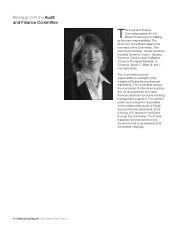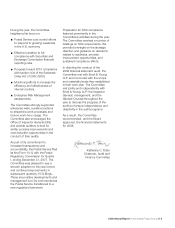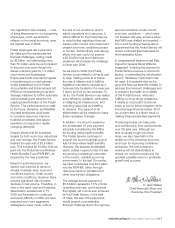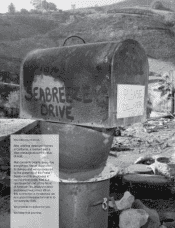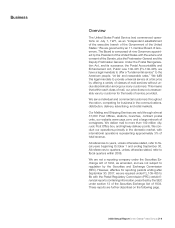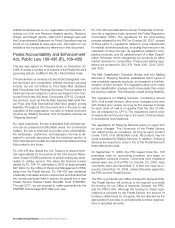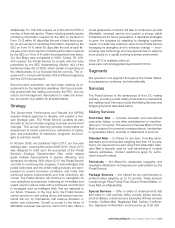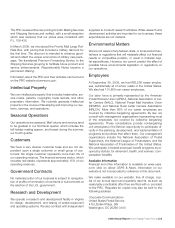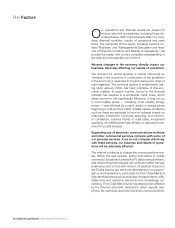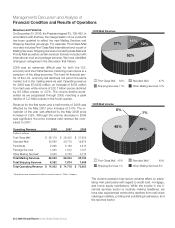US Postal Service 2008 Annual Report Download - page 20
Download and view the complete annual report
Please find page 20 of the 2008 US Postal Service annual report below. You can navigate through the pages in the report by either clicking on the pages listed below, or by using the keyword search tool below to find specific information within the annual report.
20 | 2008 Annual Report United States Postal Service
Additional disclosures on our organization and finances, in-
cluding our Cost and Revenue Analysis reports, Revenue,
Pieces, and Weight reports, Vision 2013 strategic plan and
the Comprehensive Statement on Postal Operations may be
found on our website at www.usps.com. Information on our
website is not incorporated by reference in this document.
Postal Accountability and Enhancement
Act, Public Law 109-435 (P.L.109-435)
This law was signed by President Bush on December 20,
2006. It revises a number of provisions of the Postal Service’s
governing statute, codified in title 39, United States Code.
The law divides our services into two broad categories: mar-
ket-dominant and competitive. Market-dominant services
include, but are not limited to, First-Class Mail, Standard
Mail, Periodicals, and Package Services. Price increases for
these services are subject to a price cap based on the Con-
sumer Price Index–All Urban Consumers (CPI-U). Competi-
tive services, such as Priority Mail, Express Mail, Bulk Par-
cel Post, and Bulk International Mail have greater pricing
flexibility. Throughout this document and in the day-to-day
operation of the organization, we refer to market-dominant
services as “Mailing Services” and competitive services as
“Shipping Services”.
For retail customers, the law anticipates that universal ser-
vice can be preserved at affordable prices. For commercial
mailers, the law is intended to provide price predictability.
For employees, customers, and taxpayers, the law is de-
signed to provide assurance that the employer portion of
the Postal Service’s health and retirement benefits becomes
fully funded in the future.
P.L.109-435 also directs the U.S. Treasury to resume finan-
cial responsibility for the portion of the Civil Service Retire-
ment System (CSRS) pensions of postal employees attrib-
utable to military service. This takes the financial burden
added by P.L.108-18, estimated in 2003 at approximately
$27 billion by the Office of Personnel Management (OPM),
away from the Postal Service. P.L.109-435 also abolished
a federally mandated escrow requirement and directed that
the money previously held in escrow be placed into a new
Postal Service Retiree Health Benefits Fund (PSRHBF).
Through 2017, we are required to make payments into the
PSRHBF that average $5.6 billion per year.
P.L.109-435 reconstituted the former Postal Rate Commis-
sion into a regulatory body, renamed the Postal Regulatory
Commission (PRC). The regulations for the price-setting
process released by the PRC on October 29, 2007, consist
of three parts: (1) regulations related to price adjustments
for market dominant products, including the formula for the
calculation of the price cap; (2) regulations related to com-
petitive products; and (3) establishment of a Mail Classifi-
cation Schedule, which categorizes our products as either
market dominant or competitive. These price-setting regu-
lations are contained in 39 C.F.R. Parts 3001, 3010, 3015,
and 3020.
The Mail Classification Schedule divides mail into Mailing
Services or Shipping Services, establishes which types of
mail constitute separate products, and presents a brief de-
scription of each product. The regulations allow us to make
certain classification changes much more easily than under
the previous system. This enhances overall pricing flexibility.
The regulations for Mailing Services, constituting almost
90% of all postal revenue, allow price changes every year
with limited prior review, as long as the average increase
for each class of mail is no greater than the rate of infla-
tion as measured by CPI-U. The regulations permit price
increases above the price cap in the event of extraordinary
or exceptional circumstances.
The regulations for Shipping Services place no upper limit
on price changes. The Governors of the Postal Service
can adjust prices as necessary, as long as each product
covers 100% of its attributable costs. No product may be
cross-subsidized by Mailing Services. In addition, Shipping
Services are required to cover 5.5% of the Postal Service’s
total institutional costs.
On September 11, 2008, the PRC issued Order No. 106
proposing rules on accounting practices and taxes on
competitive products income. Comments from interested
parties were due to the PRC on October 20, 2008; reply
comments were due November 3. A final rule must be is-
sued by December 19, 2008, unless otherwise agreed by
the PRC and the Postal Service.
The PRC now has its own Office of Inspector General (OIG).
The Postal Service will continue to be required to provide
the funding for our Office of Inspector General, the PRC,
and the PRC’s OIG. Although the funding for these orga-
nizations is provided by the Postal Service, the amount of
funding is determined by Congress. We are directed via the
appropriations process, to provide funds to these organiza-
tions in specified amounts.






